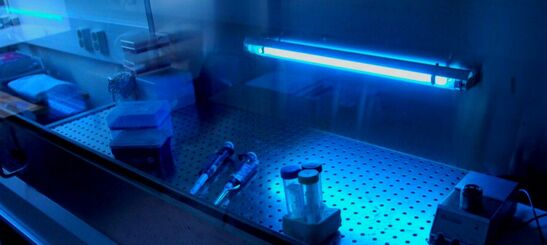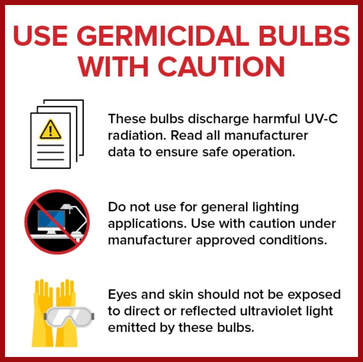 If you work in a medical or wastewater treatment facility, you are likely familiar with germicidal, or UV, lamps. For those who are not familiar with these specialty bulbs, let’s take a look at how they work and some of their common uses. Germicidal lamps produce short-wavelength ultraviolet, or UVC, light These short-wave UV light rays are between 100nm and 280nm on the spectrum of visible light. This type of light leads to the eradication of harmful bacteria and viruses by disrupting its DNA structure. They are ideal for use where disinfection is the primary goal. Germicidal lamps are also used for water and air purification and the creation of ozone. There are two types germicidal lamps commonly used: low pressure and high pressure. Low pressure lamps are most similar to fluorescent lamps, with the exception of two features. Low pressure germicidal bulbs contain no fluorescent phosphor and are made from fused quartz glass, instead of borosilicate glass like their fluorescent counterpart. They also produce a very small amount of visible light. High pressure lamps are most similar to HID, or high intensity discharge, lamps. These lamps are most commonly used in industrial water treatment facilities because they produce an intense radiation. High pressure germicidal lamps emit a bright bluish white light. *As with any fluorescent or HID lamp, germicidal lamps require the use of an external ballast to regulate the flow of current.
 Germicidal lamps require proper safety precautions pertaining to eye and skin protection. Exposure to these lamps without the right protective gear can cause sunburn, inflammation to the cornea, or damage to the retina. High exposure over time can lead to skin cancer and temporary, or even permanent, vision impairment. Since germicidal lamps provide an important function, they must be cleaned often and replaced each year to ensure high performance. Germicidal lamps are a technical product that require specific handling and can cause serious issues if used improperly. If you have any doubt, please give our Customer Service team a call at 877.231.2852 or contact us here.
4 Comments
Brittney @ Lighting Supply
5/27/2020 01:17:07 pm
Thanks for the feedback, Nigel! Glad you enjoyed the article.
Reply
10/30/2020 04:52:26 am
Hi, thank you for such a brilliant post. I have been reading some blogs that gives me more knowledge about germicidal lamps what you need to know; I must say this is one of the best among them. You have done a great research for I feel, thanks for sharing.
Reply
Your comment will be posted after it is approved.
Leave a Reply. |
This blog's content is copyright © 2014-19 Lighting Supply.
